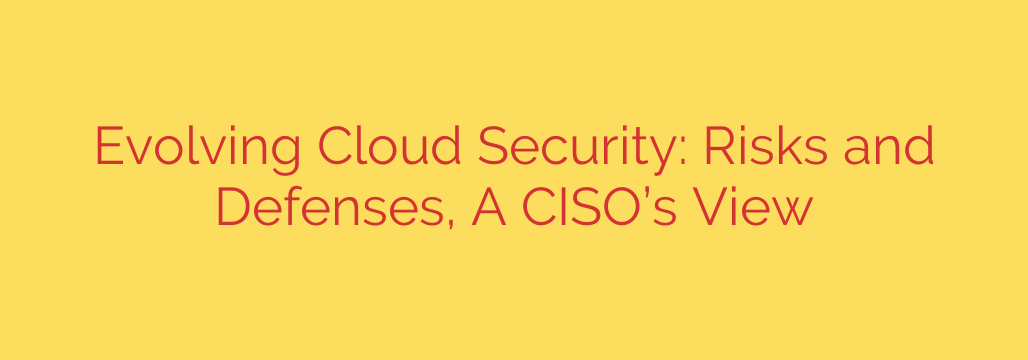
A CISO’s Guide to Mastering Cloud Security: Evolving Risks and Modern Defenses
The migration to the cloud is no longer a trend; it’s the foundation of modern business operations. This shift offers unparalleled agility, scalability, and innovation. However, this dynamic environment also presents a new and evolving set of security challenges that can leave unprepared organizations vulnerable.
Understanding and addressing these cloud security risks is paramount for any leader, from a CISO to an IT manager. The landscape has changed, and our defense strategies must evolve with it.
The Biggest Cloud Security Risks Today
While the threats are numerous, a few core vulnerabilities consistently emerge as the most significant risks to organizations operating in the cloud. Staying ahead requires a deep understanding of these common pitfalls.
Cloud Misconfigurations: This remains the single greatest threat to cloud security. A simple mistake, such as leaving a storage bucket public or assigning overly permissive access rights, can expose sensitive data to the entire internet. Due to the complexity and speed of cloud deployments, these human errors are incredibly common and are a primary target for attackers who constantly scan for these openings.
Insecure Identity and Access Management (IAM): The cloud dissolves the traditional network perimeter. Now, identity is the new firewall. Weak credentials, a lack of multi-factor authentication (MFA), and poorly managed access keys create easy entry points for malicious actors. Over-privileged accounts, both for humans and services, are a goldmine for attackers, allowing them to move laterally across your environment once inside.
Insecure APIs: Applications in the cloud communicate through Application Programming Interfaces (APIs). If these APIs are not properly secured, they can be exploited to gain unauthorized access to data and services. Think of APIs as the digital handshake between services; a weak handshake can compromise both parties.
Data Breaches and Data Loss: The ultimate goal of many cyberattacks is data. In the cloud, data is distributed, and its protection is complex. A breach can occur through a misconfigured database, compromised credentials, or malware. The consequences go beyond financial loss to include severe reputational damage and regulatory penalties.
Understanding the Shared Responsibility Model
One of the most misunderstood concepts in cloud security is the Shared Responsibility Model. It’s crucial to know where your cloud provider’s responsibilities end and where yours begin.
The Cloud Provider (e.g., AWS, Azure, GCP) is responsible for the security of the cloud. This includes the physical security of data centers, the hardware, the networking infrastructure, and the underlying virtualization layer. They ensure the platform itself is secure.
You, the customer, are responsible for security in the cloud. This is a broad category that includes managing your data, configuring access controls (IAM), securing your applications, managing operating systems and network traffic, and encrypting your data both in transit and at rest. Assuming the provider handles all security is a critical and costly mistake.
Proactive Defense: Strategies for a Resilient Cloud Environment
A reactive approach to cloud security is a losing battle. A modern defense strategy must be proactive, automated, and deeply integrated into your workflows.
Embrace “Shift Left” Security and DevSecOps: Security can no longer be an afterthought applied at the end of the development cycle. Integrating security checks and automated testing directly into the CI/CD pipeline (a practice known as DevSecOps) allows you to catch and fix vulnerabilities early, when they are cheaper and easier to resolve.
Implement a Zero Trust Framework: The old model of “trust but verify” is obsolete. A Zero Trust architecture operates on the principle of “never trust, always verify.” This means every access request, whether from inside or outside the network, must be strictly authenticated and authorized. In the cloud, where there is no clear perimeter, assuming zero trust is a fundamental security posture.
Utilize Cloud-Native Security Tools: Leverage specialized tools designed for the cloud environment.
- Cloud Security Posture Management (CSPM): These tools continuously monitor your cloud environment for misconfigurations and compliance risks, providing automated alerts and remediation.
- Cloud Workload Protection Platform (CWPP): This technology focuses on securing the workloads themselves—such as virtual machines, containers, and serverless functions—regardless of where they run.
Prioritize Continuous Monitoring and Governance: The cloud is never static. New resources are spun up and down constantly. You must have continuous, real-time visibility into your environment to detect threats and policy violations as they happen. Strong governance ensures that security policies are consistently defined and enforced across all cloud accounts and services.
The Way Forward: A Culture of Continuous Security
Navigating the cloud security landscape requires a fundamental shift in mindset. It’s not a one-time project but a continuous process of adaptation, vigilance, and improvement. By understanding the primary risks, clarifying your responsibilities, and adopting a proactive defense strategy built on automation and zero trust, you can harness the full power of the cloud without sacrificing security. The ultimate goal is not to eliminate risk entirely, but to manage it intelligently and build a resilient foundation for future growth.
Source: https://cloud.google.com/blog/products/identity-security/cloud-ciso-perspectives-new-threat-horizons-details-evolving-risks-and-defenses/








